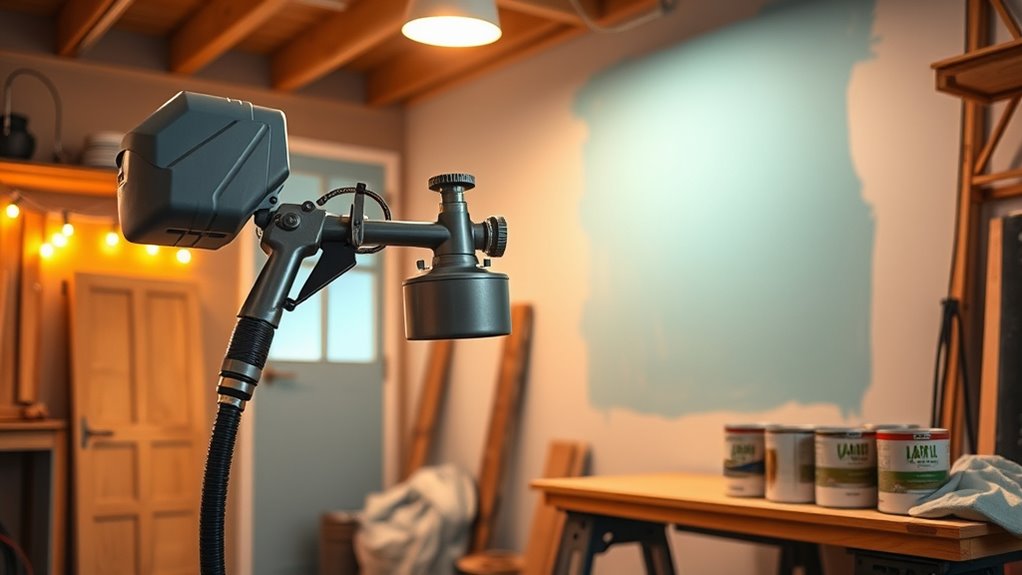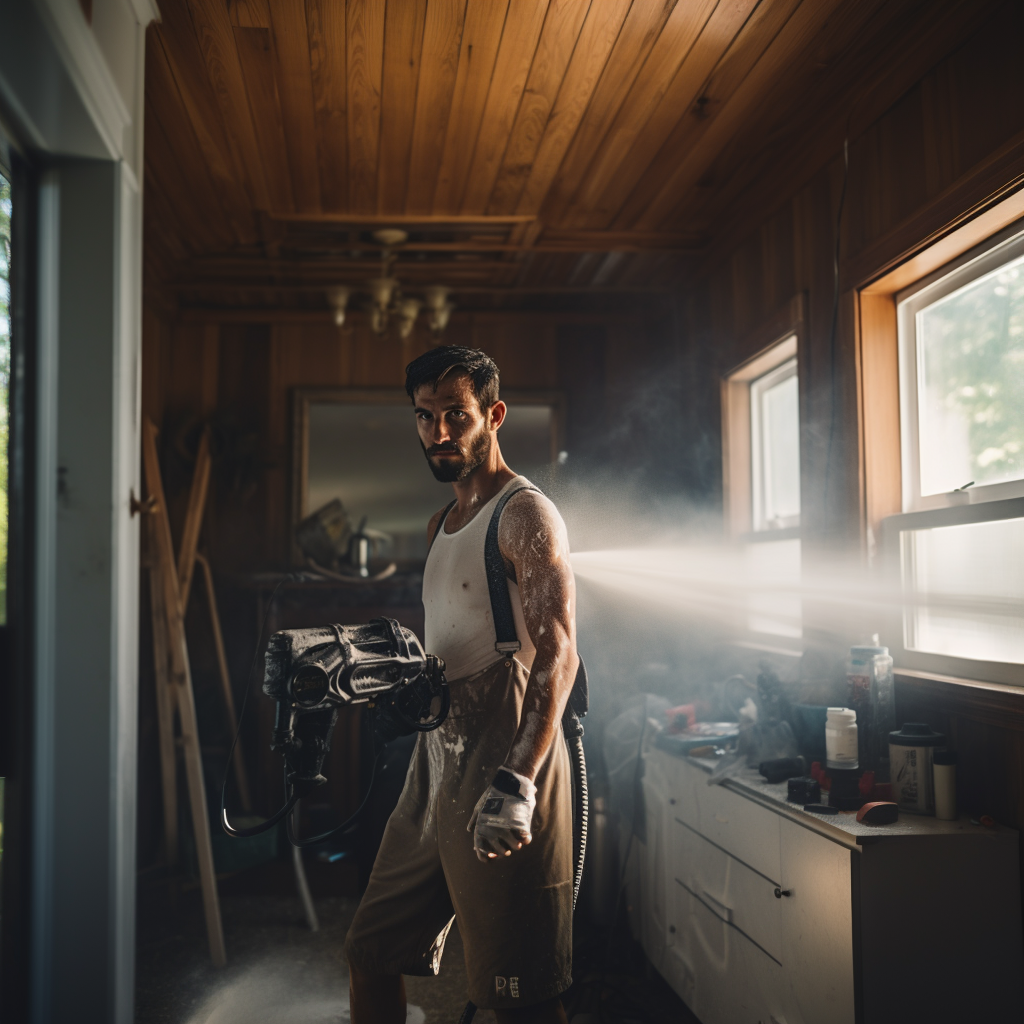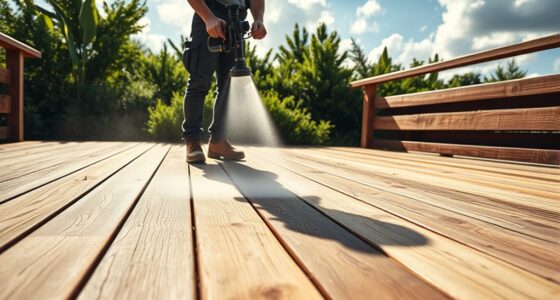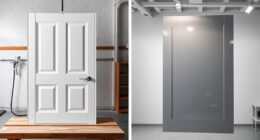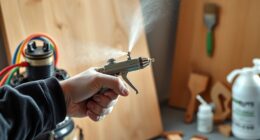Using an indoor paint sprayer in winter helps you keep your DIY projects moving year-round by providing a quick, clean, and professional finish. It speeds up the painting process, reduces mess, and allows you to experiment with textures and accents even in tight spaces. Plus, it minimizes odor and fumes, making it safer for indoor use. Keep exploring to discover simple tips and project ideas that make winter painting inspiring and easy.
Key Takeaways
- Indoor paint sprayers enable quick, professional-looking results on walls, making winter DIY projects more efficient and satisfying.
- They allow for experimenting with textures, finishes, and accent walls indoors, keeping creative projects active year-round.
- Using sprayers reduces mess and fumes, ideal for winter when outdoor ventilation isn’t feasible.
- Proper preparation and masking ensure clean, smooth finishes despite limited natural light and space constraints.
- Indoor spraying supports ongoing home improvement efforts during winter, maintaining momentum despite seasonal restrictions.
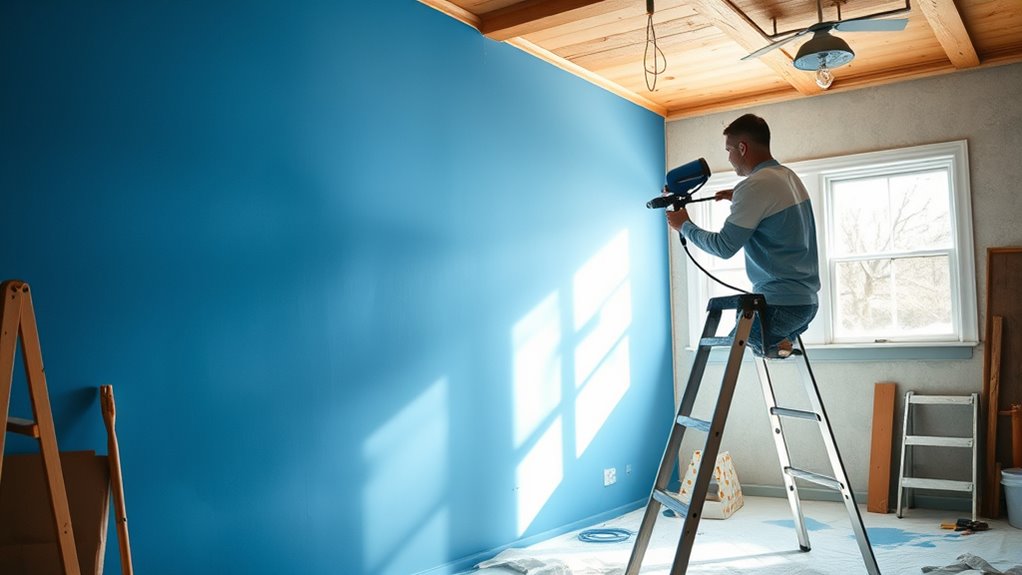
Thinking about tackling your indoor painting projects with a paint sprayer? Winter can be the perfect time to refresh your space, and using a sprayer makes the job quicker and more efficient. Plus, it allows you to achieve professional-looking results that might be difficult with brushes or rollers alone. One of the key benefits of spray painting is the ability to create seamless color blending, which is essential if you’re aiming for a smooth handover between different hues or want to add depth to your walls. With careful technique, you can layer colors effortlessly, avoiding harsh lines or streaks, and achieve a nuanced, sophisticated finish. This is especially useful in spaces where you’re experimenting with accent walls or subtle gradients, giving your room a unique visual appeal.
Another advantage is the wide range of finish textures you can accomplish with a paint sprayer. Whether you prefer a matte, eggshell, satin, or semi-gloss look, sprayers can help you achieve consistent results across large surfaces. For textured finishes, such as faux plaster or stucco effects, spray equipment allows you to control the spray pattern and pressure, giving you the ability to add dimension and character to your walls. This versatility is particularly valuable in winter when outdoor projects are limited, and you want to explore different styles and textures without investing in multiple tools. The key is to adjust your spray settings properly and practice on scrap material before tackling your main project.
Using a paint sprayer during winter also helps minimize mess and odor compared to traditional painting methods. Since the paint is atomized into fine particles, you get a smooth, even coat that reduces the need for multiple coats, saving you time and effort. Plus, modern sprayers often feature quick cleanup, so you won’t be left dealing with a pile of brushes and rollers during the colder months. When working indoors in winter, ventilation is critical, and spraying can limit your exposure to fumes, especially if you use low-VOC or eco-friendly paints. Just remember to mask off areas carefully and wear a mask to avoid inhaling fine paint particles. Incorporating a paint sprayer with safety features can further enhance your indoor painting experience.
Frequently Asked Questions
Can Indoor Paint Sprayers Be Used on Textured Surfaces?
Yes, you can use indoor paint sprayers on textured surfaces, but you need to verify sprayer compatibility first. Textured surfaces require a sprayer that can handle uneven, rough areas without clogging. Use a sprayer with adjustable pressure and a suitable nozzle size to ensure even coverage. Always test on a small area first to avoid overspray or missed spots, and adjust settings as needed for the best finish.
What Safety Gear Is Recommended for Winter Indoor Painting?
Imagine creating a cozy, safe haven with your winter painting projects. To do so, you should wear protective masks to guard your lungs and keep ventilation fans running to clear fumes. These precautions might seem simple, but they make a big difference in ensuring your health and safety. Prioritize your well-being, and you’ll enjoy your indoor painting adventures all season long with peace of mind.
How Do I Clean My Paint Sprayer After Use?
To keep your paint sprayer in top shape, you need proper paint sprayer maintenance by cleaning it thoroughly after each use. Use cleaning techniques like running warm, soapy water or solvent through the system, depending on your paint type. Disassemble parts as needed, scrub nozzles gently, and flush out residual paint. This prevents clogs and guarantees smooth operation for your next DIY project, especially during winter indoor painting.
Are There Paint Types Best Suited for Indoor Sprayers?
You should choose paint types compatible with your indoor sprayer for the best results. Latex and acrylic paints are generally ideal, offering excellent paint compatibility and smooth finishes. Avoid thick or oil-based paints unless your sprayer is specifically designed for them, as these can clog or damage your equipment. Using the right paint ensures you achieve the desired finish options while maintaining your sprayer’s performance and longevity.
How Can I Prevent Paint Fumes From Lingering Indoors?
A stitch in time saves nine, and that’s true for fumes too. To prevent paint fumes from lingering, prioritize good ventilation strategies like opening windows and using fans. Also, consider odor neutralizers to absorb residual smells. You might also run an air purifier with activated charcoal. These steps keep indoor air fresh and safe, ensuring your winter DIY projects stay enjoyable without the fumes sticking around.
Conclusion
So, there you have it—winter’s not a wall you hit, but a paint project waiting to happen. With your trusty indoor sprayer, you’ll turn that chilly season into a colorful adventure, all while pretending you’re on a professional set. Who needs sunshine when you’ve got a roller’s rhythm and a sprayer’s spray? Keep DIY-ing, keep warm, and remember: the only thing more colorful than your walls is your winter excuse to stay inside.
Franz came aboard the Paint Sprayer Zone team with a background in both journalism and home renovation. His articulate writing style, combined with a passion for DIY projects, makes him an invaluable asset. Franz has a knack for breaking down technical jargon into easy-to-understand content, ensuring that even the most novice of readers can grasp the complexities of paint sprayers.
